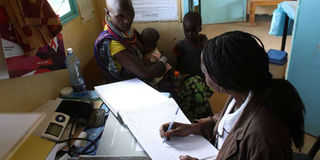Invest in community health workers

A health worker registers a child after administering measles immunisation at Ewasu Dispensary in Laikipia County in 2016. PHOTO | FILE | NATION MEDIA GROUP
What you need to know:
With this life-saving knowledge, and basic equipment and medicine, community health workers can quickly diagnose and treat people within their neighbourhoods.
Large-scale community health workers systems require substantial increases in support for training, management, supervision and logistics.
A widely accepted definition of a community health worker proposed by a World Health Organisation (WHO) Study Group (1989) is: “Community health workers (CHWs) should be members of the communities where they work, should be selected by the communities, should be answerable to the communities for their activities, should be supported by the health system, but not necessarily a part of its organisation, and have shorter training than professional workers.”
Since Alma-Ata Declaration of 1978, the CHWs have acted as a link between the community and health systems.
Nowadays, their role, in collaboration with the mid-level health workers (MLHWs), is imperative in achieving the health-related Millennium Development Goals (MDGs) — especially HIV and Aids, malaria, tuberculosis (TB), maternal mortality and childhood diseases.
From rural communities in Africa to cities in Europe and North America and the densely populated parts of Asia, CHW training has been established and is evolving to meet the growing health needs of large populations.
HEALTH WORKER CRISIS
The health worker crisis, especially in sub-Saharan Africa, has triggered a renewed interest in CHWs, as they have the potential to take over a number of tasks from the professional health workers.
In Africa, the crisis is particularly acute in the rural and hard-to-reach areas, where 80 per cent of the population lives.
The use of CHWs has been identified as a strategy to address the growing shortage of health workers, particularly in the low-income countries.
CHWs may include community health agents, village health workers, traditional birth attendants, community drug or insecticide-treated net distributors and health promoters. They are selected by their own communities.
The government should invest more in CHWs. If they receive basic medical training involving treating mothers and babies with malaria, helping TB patients to take their treatment and educating communities on HIV/Aids prevention, family planning, hygiene and nutrition, we can achieve health milestones.
With this life-saving knowledge, and basic equipment and medicine, they can quickly diagnose and treat people within their neighbourhoods.
UNDER-STAFFIED CLINICS
Training health workers who live close to homes ensures that patients no longer lose vital time travelling long distances to health facilities and under-staffed health clinics are less congested with patients who can safely be treated at home.
CHWs should be seen as frontrunners with the primary responsibility of mobilising communities to participate in health-related activities at the grassroots.
By design, they are supposed to work with and receive supportive supervision from mid-level health workers and the communities they serve.
However, several evaluations have documented the weakness of supervision and support in national CHW programmes, which is either irregular or non-existent.
Experiences with CHW programmes show that there is consensus on a number of issues.
First, CHWs can make a valuable contribution to community development and, more specifically, improve access to and coverage of communities with basic health services.
USEFUL DATA
They are best indicated to collect useful data on vital events occurring within their neighbourhoods and thus contribute to a better community-based health management information system (CBHMIS).
Secondly, for CHWs to make an effective contribution, they must be carefully selected, appropriately trained and supervised and — very importantly — adequately and continuously supported.
Large-scale CHW systems require substantial increases in support for training, management, supervision and logistics. CHWs cannot be stuck in the field and left on their own to work without supervisory and support.
Third, CHW programmes are neither the panacea for weak health systems nor a cheap option to providing access to healthcare for under-served populations. Numerous programmes have failed due to unrealistic expectations, poor planning and an under-estimation of the effort and input required to make them work.
TRAINED DOCTORS
Fourth, by their very nature, CHW programmes are vulnerable unless they are driven, owned by and firmly embedded in communities themselves.
Whilst CHWs do not have the same abilities as trained doctors or nurses, they are trained to recognise complicated cases and refer them to health facilities.
They are effective because they are members of the communities they serve; they and their clients have shared experiences, language and understanding, which allow for trust to flourish.
CHWs are a lifeline for hundreds of thousands of people who would otherwise not have access to healthcare.
Mr Kitavi is the executive director, Youth Development Forum. [email protected]





